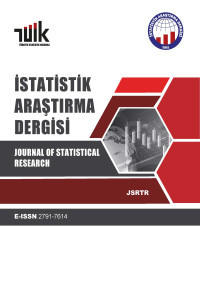Genetik Algoritma Tabanlı Kısmi En Küçük Kareler Regresyonu için Değişken Seçimi
Değişken seçimi, Genetik algoritma, İz düşüm için değişken önemi, Kısmi en küçük kareler regresyonu
Genetic Algorithm Based Variable Selection For Partial Least Squares Regression
Genetic algorithms, Partial least square regressions, Variable selection, Variable importance for projection,
___
- Andersen, C. M., Bro, J. R., 2010. Variable Selection in Regression - A Tutorial. Chemometrics, 24, 728-737.
- Chong, I-G., Jun, C. H., 2005. Performance of Some Variable Selection Methods when Multicollinearity is Present. Chemometrics and Intelligent Laboratory Systems, 78, 103- 112.
- Garthwaite, P. H., 1994. An Interpretation of Partial Least Squares. Journal of the American Statistical Association, 89, 122-127.
- Gurunlu Alma Ö., Bulut E., 2012. Genetic Algorithm Based Variable Selection for Partial Least Squares Regression Using ICOMP Criterion, Asian Journal of Mathematics and Statistics, 5(3), 82-92.
- Guyon, I., Elisseeff, A., 2003. An Introduction to Variable and Feature Selection. Journal of Machine Learning Research, 3, 1157-1182.
- Goldberg, D.E., 1989. Genetic Algorithms in Search, Optimization and Machine Learning. Addison-Wesley, USA.
- Hollander, M., Wolfe, D. A., 1973. Nonparametric Statistical Methods. John Wiley & Sons: New York, NY.
- Hörchner, U., Kalivas, J. H., 1995. Further Investigation on a Comparative Study of Simulated Annealing and Genetic Algorithm for Wavelengths Selection. Analytica Chimica Acta, 311, 1-13.
- Jöreskog, K. G., Wold, H., 1982. Systems Under Indirect Observation, Part I, 263-270. Amsterdam, New York, Oxford: North-Holland.
- Jun, C. H., Lee, S. H., Park, H. S., Lee, J. H., 2009. Use of Partial Least Squares Regression for Variable Selection and Quality Prediction. Computers & Industrial Engineering. CIE 2009. International Conference on 6-9 July 2009.
- Kubinyu H., 1996. Evolutionary Variable Selection in Regression and PLS Analyses. Journal of Chemometrics, 10, 110-133.
- Leardi, R., Boggia, R., Terrile, M., 1992. Genetic Algorithms as a Strategy for Feature Selection, Journal of Chemometrics, 6, 267-281.
- Leardi, R., 1996. Genetic Algorithms in Feature Selection, in: J. Devillers_Ed., Genetic Algorithms in Molecular Modeling, Academic Press., 67.
- Leardi, R., 2001. Genetic Algorithms in Chemometrics and Chemistry: A Review. Journal of Chemometrics, 15, 559-569.
- Leardi, R., Gonza´lez, A. L., 1998. Genetic Algorithms Applied to Feature Selection in PLS Regression: How and When to Use Them. Chemometrics and Intelligent Laboratory Systems, 41, 195–207.
- Li, B., Morris, J., Martin, E. B., 2002. Model Selection for Partial Least Squares Regression. Chemometrics and Intelligent Laboratory Systems, 64, 79-89.
- Lindgren, F., Rännar S., 1998. Alternative Partial Least-Squares (PLS) Algorithms. Perspectives in Drug Discovery and Design. 12-14, 105-113.
- Lucasius, C. B., Beckers, M. L. M., Kateman, G., 1994. Genetic Algorithms in Wavelengths Selection: A Comparative Study. Analytical Chimica Acta, 286, 135–153.
- Masamoto, A., Yosuke, Y., Kimito, F., 2011. Genetic Algorithm-Based Wavelength Selection Method for Spectral Calibration. Journal of Chemometrics, 25, 10–19.
- Martens H., Naes T., 1989. Multivariate Calibration. John Wiley & Sons.
- Naes, T., Martens, H., 1985. Comparison of Prediction Methods for Collinear Data, Communication in Statistics Simulation and Computation, 14, 545-576.
- Paterlini, S., Minerva, T., 2010. Regression Model Selection using Genetic Algorithms. Recent Advances in Neural Networks, Fuzzy Systems & Evolutionary Computing, WSEAS Press Stevens Point, Wisconsin, 19-28.
- Shariati-Rad, M., Hasani, M., 2010. Selection of Individual Variables versus Intervals of Variables in PLSR. Journal of Chemometrics, 24, 45–56.
- Vitor, L., Carla C. P., José C. M. 2000. Evolutionary Programming for Variable Selection in PLSR: Predicting Qualities from a Crude Distillation Unit, Controlo’2000:4th Portuguese Conference on Automatic Control.
- Wold, H., In David, F., 1966. Research papers in statistics. Wiley, New York, 411-444.
- Wold, S., Martens, M., Wold, H., 1983. The Multivariate Calibration Problem in Chemistry Solved By The PLS Method. In Ruhe, and Kågstrom, B. (Eds) Matrix Pencils, Springer-Verlag, Hieldelberg, Germany. 286-293.
- Wold, S., Ruhe, A., Wold, H., Dunn III, W. J., 1984. The Collinearity Problem in Linear Regression: The Partial Least Squares Approach to Generalized Inverses. Siam J. Sci. Stat. Comput, 5, 735-743.
- Wold, S., Johansson, E., Cocchi, M., 1993. 3D QSAR in Drug Design; Theory, Methods and Applications. ESCOM, Leiden, Holland, 523-550.
- Wold, S., 1994. PLS For Multivariate Linear Modelling, QSAR: Chemometric Metods in Molecular Design. Methods and Principles in Medicinal Chemistry. (Ed. H. Van de Waterbeemd), Weinheim, Germany: Verlag-Chemie.
- Wold, S., Kettaneh, N., Tjessem, K., 1996. Hierarchical Multiblock PLS and PC Models for Easier Model Interpretation and as an Alternative to Variable Selection. Journal of Chemometrics, 10, 463-482.
- Wold, S., Sjöström, M., Eriksson, L., 2001. PLS-Regression: A Basic Tool of Chemometrics. Chemometrics and Intelligent Laboratory Systems, 58, 109-130.
- ISSN: 1303-6319
- Başlangıç: 2002
- Yayıncı: TÜİK
Normal Müdahaleli Ödüllü Yenileme Sürecinin Sınır Fonksiyonelleri Üzerine
Zulfiyya MAMMADOVA, Tahir KHANİYEV, İhsan ÜNVER
Örneklemeye Dayalı Araştırmaların Tarihçesi
Türkiye’de -Osmanlıdan Günümüze- İstatistik Tarihine Bakış
Basit Doğrusal Regresyonda Sağlam ve Theil Kestiricilerinin Karşılaştırılması
Onur TOKA, Meral ÇETİN, Serpil AKTAŞ ALTUNAY
Kesirli Çok Etkenli Tasarımlar ve Kodlar
Genetik Algoritma Tabanlı Kısmi En Küçük Kareler Regresyonu için Değişken Seçimi
